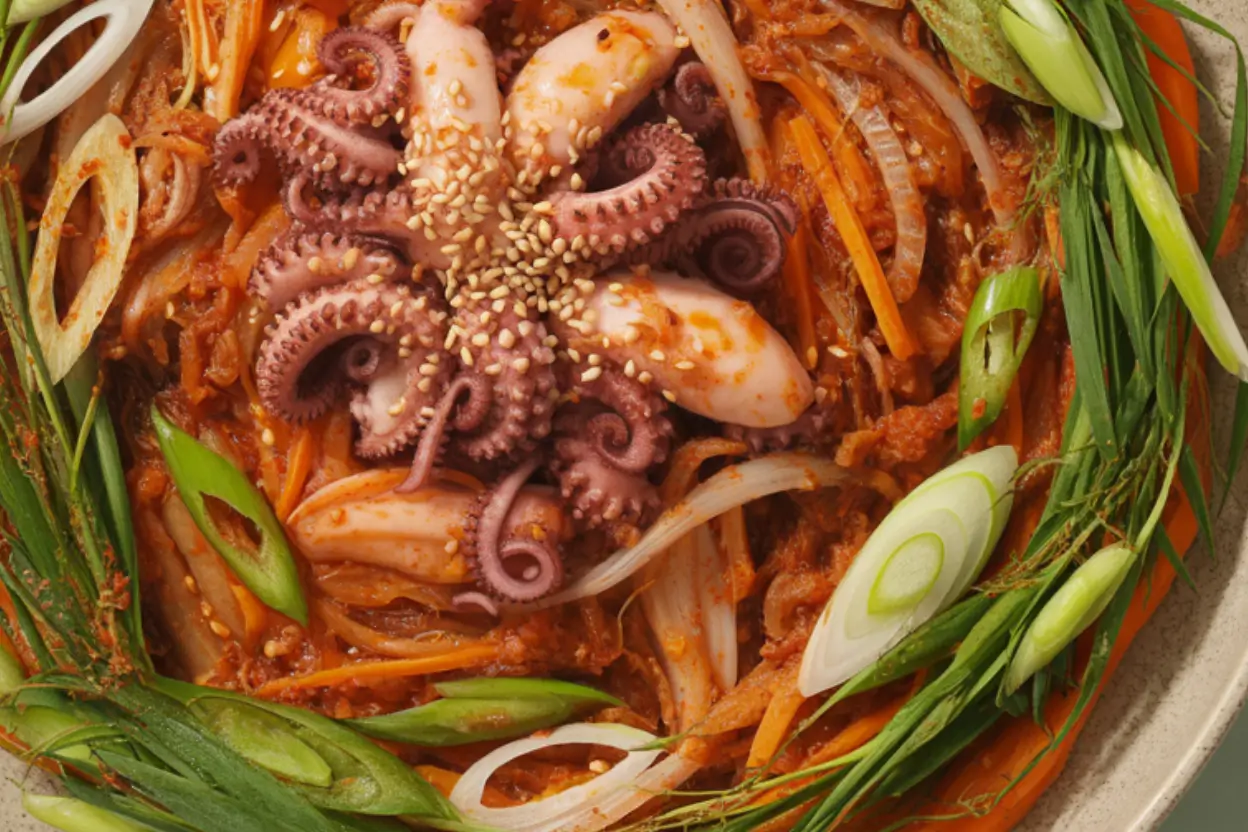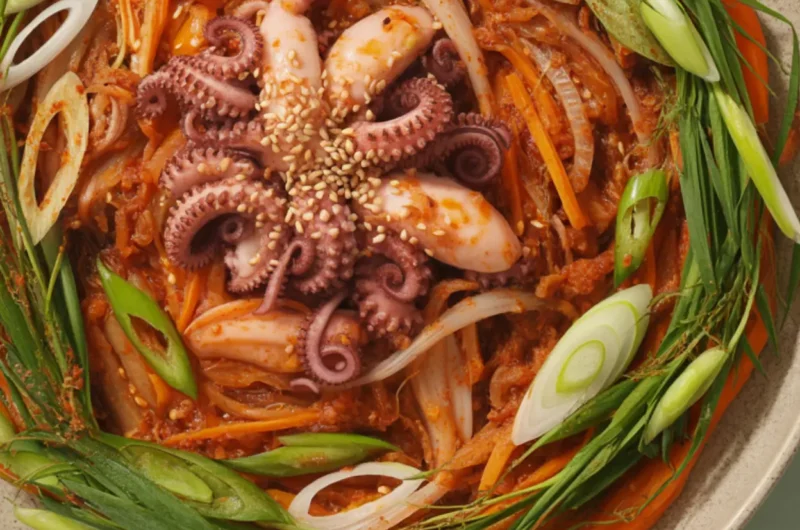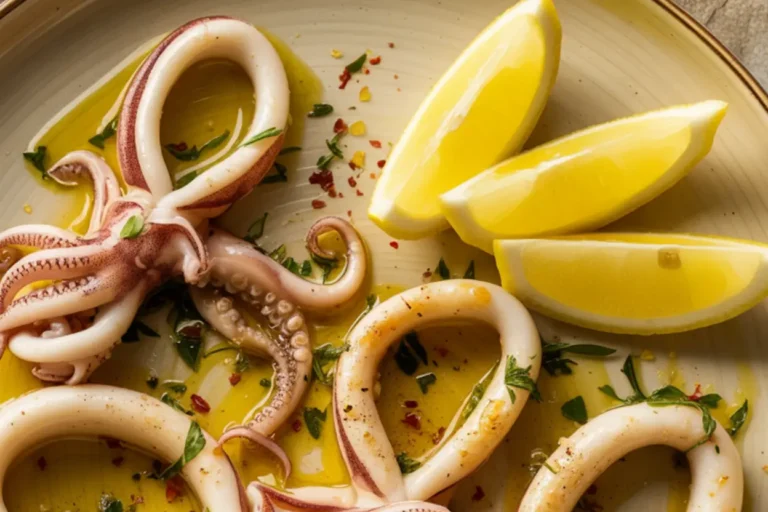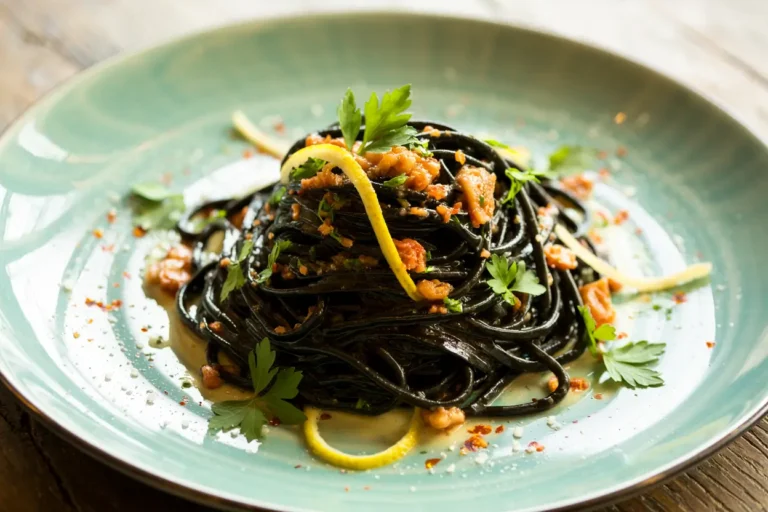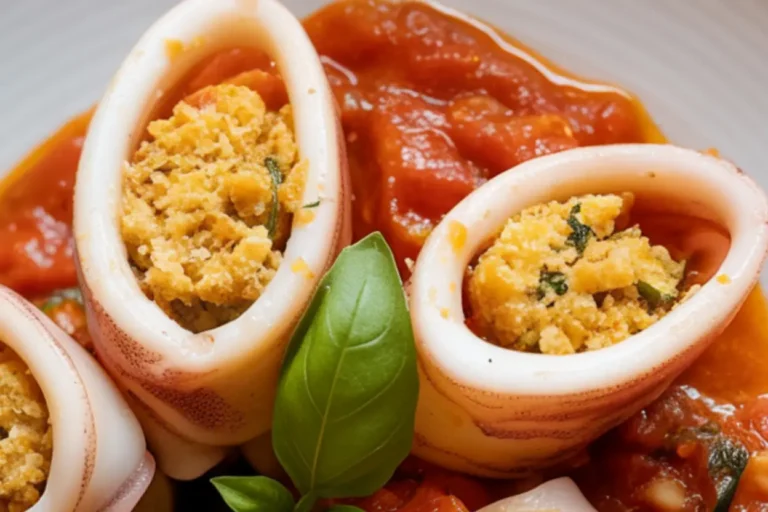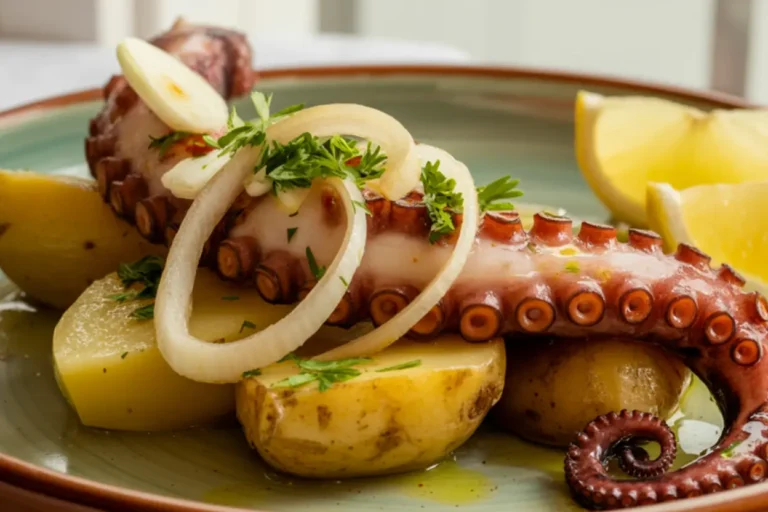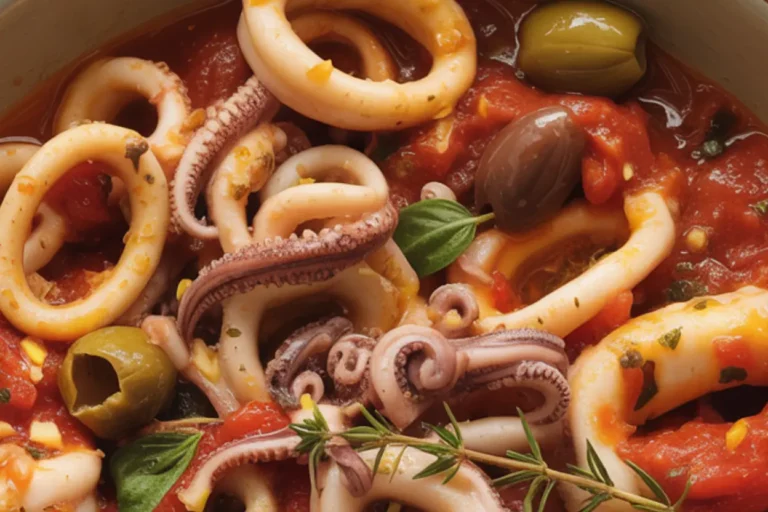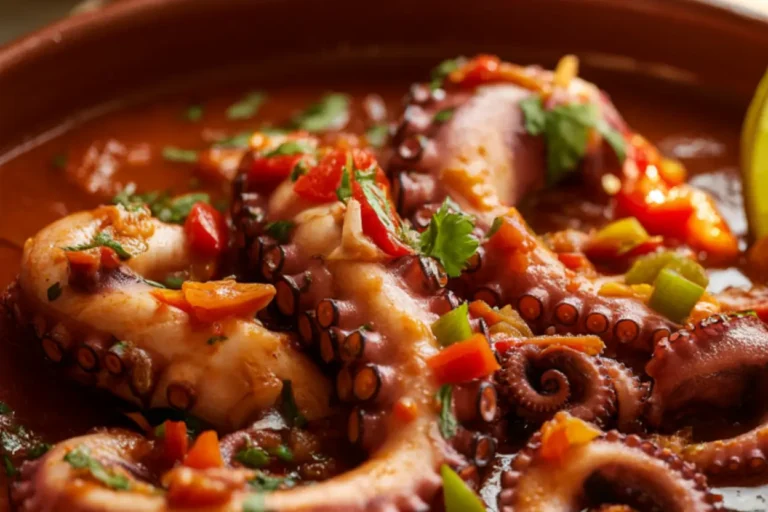Nakji bokkeum recipe: How to Make It Like a Korean Local
Table of Contents
When I first encountered Nakji Bokkeum at a small family-owned restaurant in Seoul’s Myeongdong district, I knew this fiery octopus stir-fry would become a staple in my home cooking repertoire. The balance of spicy gochugaru, tender baby octopus, and crisp vegetables creates a symphony of flavors that’s both addictive and deeply satisfying. Today, I’m sharing my perfected Nakji Bokkeum recipe that brings authentic Korean flavors straight to your kitchen.
Thank you for reading this post, don't forget to subscribe!How to Make Nakji Bokkeum
Quick Overview
Nakji Bokkeum is a spicy Korean stir-fried octopus dish that delivers an explosion of flavors in every bite. What makes this dish special is the perfect balance between the tender, slightly chewy texture of baby octopus and the bold, spicy gochujang-based sauce that coats every morsel. The vibrant red color is as enticing as the aroma that fills your kitchen during preparation.
This dish comes together in just 35 minutes, making it perfect for weeknight dinners when you want something impressive without spending hours in the kitchen. The quick cooking process preserves the octopus’s tender texture while allowing the vegetables to maintain their slight crunch. Despite its intimidating appearance, this dish is surprisingly approachable for home cooks of all skill levels.
The Ingredients I Use to Bring My Nakji Bokkeum to Life
For the Octopus:
- 1.5 pounds (700g) baby octopus (nakji), cleaned and cut into bite-sized pieces
- 1 tablespoon sea salt (for cleaning)
- 2 tablespoons potato starch (for coating)
For the Sauce:
- 4 tablespoons gochugaru (Korean red pepper flakes)
- 3 tablespoons gochujang (Korean red pepper paste)
- 2 tablespoons soy sauce
- 2 tablespoons brown sugar
- 1 tablespoon sesame oil
- 1 tablespoon minced garlic
- 1 tablespoon minced ginger
- 1 tablespoon roasted sesame seeds
- 2 tablespoons water (to adjust consistency)
For the Vegetables:
- 1 medium onion, sliced
- 1 carrot, julienned
- 1 green bell pepper, sliced
- 1 red bell pepper, sliced
- 2 stalks green onions, cut into 2-inch lengths
- 1 tablespoon vegetable oil (for stir-frying)
Garnish:
- 2 tablespoons chopped green onions
- 1 tablespoon toasted sesame seeds
- Fresh perilla leaves (optional)
Step-by-Step Instructions
Preparing the Octopus
- Clean the octopus thoroughly: Place the baby octopus in a bowl and rub it with 1 tablespoon of sea salt. Rinse under cold running water at least 3 times until the water runs clear. This helps remove any sliminess and impurities.
- Cut into manageable pieces: If the octopus hasn’t been prepared yet, cut the tentacles into 2-inch pieces and the head into bite-sized pieces. If you’re using a larger octopus, make sure to cut it into smaller, even pieces to ensure quick and even cooking.
- Pat dry and coat: Using paper towels, pat the octopus pieces dry thoroughly. Sprinkle with potato starch and toss to coat lightly. This helps create a slight texture that allows the sauce to adhere better.
Making the Sauce
- Combine the sauce ingredients: In a medium bowl, mix together the gochugaru, gochujang, soy sauce, brown sugar, sesame oil, minced garlic, minced ginger, and roasted sesame seeds. Stir until the sugar dissolves and you have a smooth, consistent paste.
- Adjust consistency: Add 2 tablespoons of water to the sauce mixture and stir well. The sauce should be thick enough to coat a spoon but not so thick that it won’t distribute evenly during cooking.
Preparing the Vegetables
- Prepare all vegetables: Slice the onion into thin half-moons, julienne the carrot, and slice the bell peppers into thin strips. Cut the green onions into 2-inch segments, separating the white parts from the green tops (save some green parts for garnish).
Cooking the Nakji Bokkeum
- Preheat your wok or skillet: Place a large wok or heavy-bottomed skillet over high heat. When it’s hot (you should see slight wisps of smoke), add the vegetable oil and swirl to coat the cooking surface.
- Stir-fry the aromatics: Add the white parts of the green onions, minced garlic, and ginger to the hot oil. Stir-fry for about 30 seconds until fragrant, being careful not to burn them.
- Add the vegetables: Add the onions and stir-fry for about 1 minute until they begin to soften. Then add the carrots and continue stir-frying for another minute. Finally, add the bell peppers and cook for 30 seconds.
- Cook the octopus: Push the vegetables to the sides of the wok and add the prepared octopus to the center. Stir-fry for 2-3 minutes until it starts to curl and turn opaque.
- Combine with sauce: Pour the prepared sauce over everything in the wok. Stir quickly to coat all ingredients evenly. Continue to stir-fry for another 2-3 minutes until the octopus is fully cooked but still tender. Be careful not to overcook, as octopus can become tough.
- Finish the dish: Add the green parts of the green onions and toss everything together for about 30 seconds. The sauce should coat everything nicely and have thickened slightly.
- Garnish and serve: Transfer to a serving plate, sprinkle with additional chopped green onions and toasted sesame seeds. Add fresh perilla leaves around the edges if using.
What to Serve Nakji Bokkeum With
Nakji Bokkeum is a bold, flavorful main dish that pairs beautifully with several Korean side dishes and accompaniments:
- Steamed white rice: The perfect canvas to balance the spicy stir-fry. The mild, fluffy rice helps temper the heat of the dish.
- Banchan selection: Serve with a variety of small side dishes such as kimchi, seasoned spinach (sigeumchi namul), or bean sprouts (kongnamul).
- Lettuce or perilla leaves: These fresh greens can be used to make little wraps with the Nakji Bokkeum and rice, creating a perfect bite with contrasting textures.
- Cold cucumber soup (oi naengguk): The cool, refreshing nature of this soup provides a perfect counterbalance to the spicy octopus.
- Barley tea (boricha): This nutty, caffeine-free tea cleanses the palate between bites and helps digest the rich meal.
- Steamed egg (gyeran jjim): A soft, savory steamed egg dish provides a gentle contrast to the bold flavors of the Nakji Bokkeum.
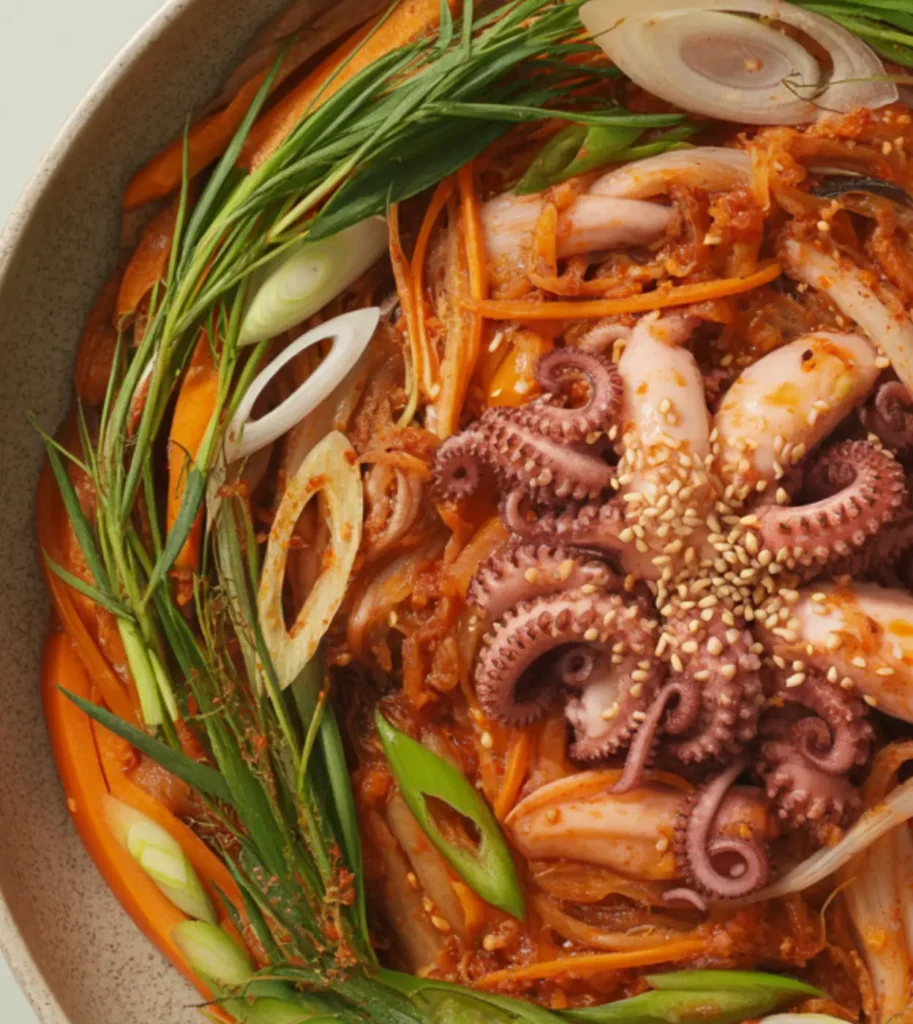
Top Tips for Perfecting Nakji Bokkeum
- Don’t skip the octopus cleaning step: Properly cleaning the octopus with salt removes excess slime and improves the texture dramatically. If the octopus still seems slimy after rinsing, try blanching it in boiling water for 30 seconds before patting dry.
- Control the spice level: Adjust the amount of gochugaru and gochujang based on your heat tolerance. For a milder version, reduce these ingredients by half; for authentic Korean heat, use the full amount.
- Cooking time matters: Octopus requires a delicate balance in cooking time. Too short and it will be rubbery; too long and it becomes tough. The sweet spot is usually 4-5 minutes total cooking time for baby octopus.
- Ingredient substitutions: If baby octopus is hard to find, you can use squid instead. The cooking process is similar, but squid cooks even faster (2-3 minutes total).
- Add vegetables in stages: The staggered addition of vegetables ensures each one achieves the perfect texture. Onions need longer cooking time than bell peppers, which should retain some crunch.
- Prep everything beforehand: This dish comes together quickly once you start cooking, so having all ingredients prepped and ready is essential (mise en place).
- Use a high-heat cooking vessel: A well-seasoned wok or cast-iron skillet provides the best results as they can handle the high heat needed for proper stir-frying.
Storing and Reheating Tips
Nakji Bokkeum is best enjoyed fresh, but leftovers can be stored and enjoyed later with these guidelines:
- Refrigeration: Keep leftovers in an airtight container in the fridge for up to 2 days. The flavors often intensify overnight, making next-day Nakji Bokkeum even more delicious.
- Freezing: While possible, freezing isn’t ideal as the texture of the octopus and vegetables will change. If you must freeze, store in a freezer-safe container for up to 1 month. Thaw overnight in the refrigerator before reheating.
- Reheating method: The best way to reheat Nakji Bokkeum is in a skillet over medium heat. Add 1-2 tablespoons of water to the cold dish, then heat while stirring occasionally until thoroughly warmed (about 3-4 minutes). This prevents the dish from drying out.
- Microwave alternative: If using a microwave, place the Nakji Bokkeum in a microwave-safe dish, sprinkle with a few drops of water, cover with a microwave-safe lid or a damp paper towel, and heat on 70% power for 1-2 minutes, stirring halfway through.
- Revitalizing leftovers: Add a squeeze of fresh lime juice and a sprinkle of fresh green onions just before serving reheated Nakji Bokkeum to brighten the flavors back up.
This Nakji Bokkeum recipe brings the vibrant flavors of Korean street food right to your dining table. The combination of tender octopus, crisp vegetables, and that irresistible spicy sauce creates an unforgettable meal that’s sure to impress even the most discerning palates. Don’t be intimidated by the ingredient list—once you’ve made this dish once, it’ll become a go-to favorite in your culinary repertoire.
Nakji bokkeum recipe: How to Make It Like a Korean Local
Cuisine: koreanDifficulty: Medium4
servings25
minutes12
minutes320–350
kcalNakji Bokkeum is a fiery and flavorful Korean stir-fry made with tender baby octopus and a bold gochujang-based sauce. Mixed with colorful vegetables and finished with sesame seeds and fresh perilla leaves, this dish is packed with texture, heat, and umami.
Ingredients
1.5 pounds (700g) baby octopus (nakji), cleaned and cut into bite-sized pieces
1 tablespoon sea salt (for cleaning)
2 tablespoons potato starch (for coating)
4 tablespoons gochugaru (Korean red pepper flakes)
3 tablespoons gochujang (Korean red pepper paste)
2 tablespoons soy sauce
2 tablespoons brown sugar
1 tablespoon sesame oil
1 tablespoon minced garlic
1 tablespoon minced ginger
1 tablespoon roasted sesame seeds
2 tablespoons water (to adjust consistency)
1 medium onion, sliced
1 carrot, julienned
1 green bell pepper, sliced
1 red bell pepper, sliced
2 stalks green onions, cut into 2-inch lengths
1 tablespoon vegetable oil (for stir-frying)
2 tablespoons chopped green onions
1 tablespoon toasted sesame seeds
Fresh perilla leaves (optional)
Directions
- Prepare the Octopus
Clean the baby octopus thoroughly by rubbing it with sea salt, then rinse under cold water until the water runs clear. Cut the tentacles and head into bite-sized pieces if not already done. Pat the octopus dry using paper towels, then lightly coat with potato starch to help the sauce stick during cooking. - Make the Sauce
In a bowl, combine gochugaru, gochujang, soy sauce, brown sugar, sesame oil, minced garlic, minced ginger, and roasted sesame seeds. Stir until smooth, then add water to slightly thin out the sauce for easier mixing during the stir-fry. - Prep the Vegetables
Slice the onion into half-moons, julienne the carrot, and thinly slice the green and red bell peppers. Cut the green onions into 2-inch segments, separating the white and green parts. Save a few green tops for garnish later. - Cook and Serve
Heat oil in a hot wok or skillet, then stir-fry the white parts of the green onions, garlic, and ginger until fragrant. Add the onions, carrots, and bell peppers, stir-frying in stages until slightly softened. Push the vegetables aside, add the octopus, and stir-fry until it turns opaque. Pour in the sauce and stir well to coat. Add the green onion tops, stir for 30 seconds, then garnish with sesame seeds, extra green onions, and optional perilla leaves before serving.
Notes
- Nakji Bokkeum is a popular Korean dish known for its bold spice and tender octopus. Using potato starch during cleaning helps remove any fishy odor and improves texture. The gochujang and gochugaru bring the signature Korean heat, while fresh vegetables balance the dish with sweetness and crunch. For extra authenticity, serve it with steamed rice or wrap it in perilla leaves for a burst of herbal freshness.

